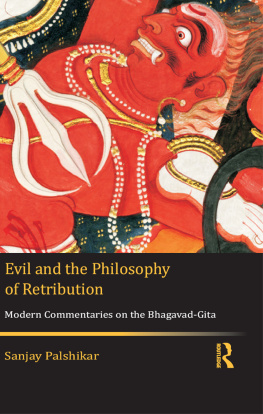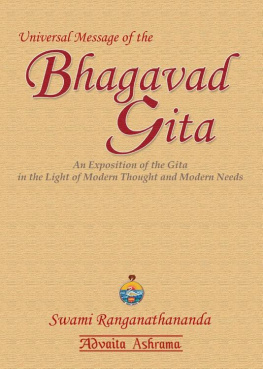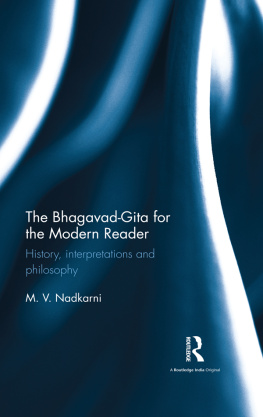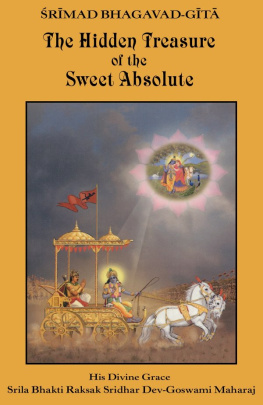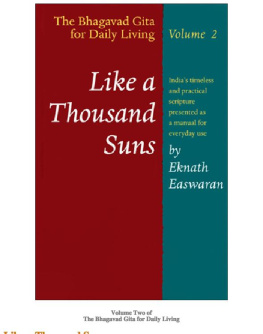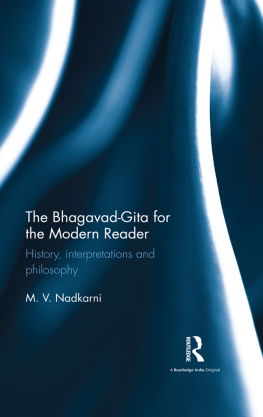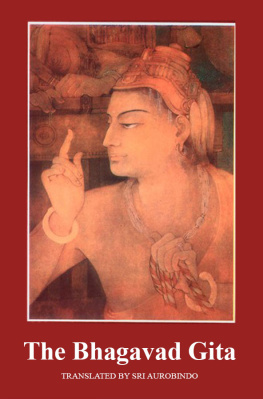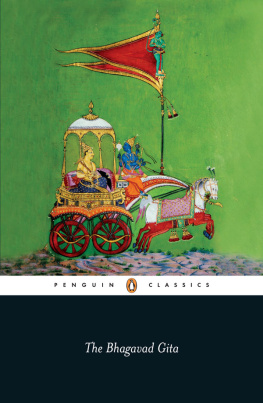
Evil and the Philosophy of Retribution
Evil and the Philosophy of Retribution
Modern Commentaries on the Bhagavad-Gita
SANJAY PALSHIKAR

First published 2014 in India
by Routledge
912 Tolstoy House, 1517 Tolstoy Marg, Connaught Place, New Delhi 110 001
Simultaneously published in the UK
by Routledge
2 Park Square, Milton Park, Abingdon, Oxon OX14 4RN
Routledge is an imprint of the Taylor & Francis Group, an informa business
2014 Indian Institute of Advanced Study (IIAS), Shimla
Typeset by
Glyph Graphics Private Limited
23, Khosla Complex
Vasundhara Enclave
Delhi 110 096
All rights reserved. No part of this book may be reproduced or utilised in any form or by any electronic, mechanical or other means, now known or hereafter invented, including photocopying and recording, or in any information storage and retrieval system without permission in writing from the publishers.
British Library Cataloguing-in-Publication Data
A catalogue record of this book is available from the British Library
ISBN 978-0-415-71114-2
Contents
E vil is a charged word. It is used for persons and phenomena uncontrollably destructive and morally recalcitrant. Reserving the word for such cases of epic proportions has merit. We should not make it conceptually impossible for people to be bad in mundane ways. Evil and violence are connected in complex and contentious ways. Evil is violent itself it is violative of the sacred or the divine and hence, it might be claimed, using physical force against it is no violence at all. It is easy to see what is it about this argument that causes disagreement. It is not the conceptual connection that is normally disputed but the attribution of evilness and the implicit presumption of goodness that can quickly become controversial outside the circles of habitual consensus. In the early 20th-century Gita commentaries by prominent Indian thinkers, the relationship between evil and violence was seen as a philosophical matter in need of defence or scrutiny. The centrality of the Gita to the emerging Hindu self-consciousness had of course something to do with the sense of urgency with which these issues were reflected upon. But the causality between the growing importance of the text and the tangled process of self-formation of the Indian intellectuals was dense and mutual. The work presented here does not try to find out how this web of interconnected activities and phenomena came into being. Instead it engages with the answers given by Aurobindo Ghose, Bal Gangadhar Tilak and Mohandas Karamchand Gandhi to the specific question whether exceptional figures dealing with exceptional situations are absolved of universal norms of morality.
If the philosophical task of coming to terms with evil was urgent during the colonial period, it is no less important today. True, there are no influential treatises on the epic struggle between the good and the evil circulating today. But popular culture is full of examples of ones adversaries being represented as demons. On the eve of the 2011 World Cup final between India and Sri Lanka, the Indian captain Mahendra Singh Dhoni was presented in an advertisement as Sri Rama and the 11-member Sri Lankan cricket team as the 10-headed Ravan. The accompanying caption prophesied that India was going to re-enact history. The mythologically
These anxieties get heightened by communal politics. But it is helpful to remember that any adversary can be demonised. The discussion of the three modern commentaries here has a purpose different from placing the authors into familiar but problematic categories such as secular and communal. Going into past representations of evil and their transformation under modern conditions is primarily an exercise in intellectual history. What is attempted here is an inquiry into how the pre-modern questions about spiritual praxis become, through a change in the meaning of some of the central concepts, political questions in the modern Gita commentaries.
Most of the work presented here was carried out at the Indian Institute of Advanced Study, Shimla. It had its origins in a series of informal discussions with Jyotirmaya Sharma at the University of Hyderabad. At the Institute, Sibaji Bandyopadhyays 2009 essay (which was later published in the Institutes journal Studies in Humanities and Social Sciences) and the 2010 special number of the journal Modern Intellectual History on the Gita were the early and decisive influences, and I must thank Manas Ray and Tridip Suhrud respectively for drawing my attention to them. By the time I completed the first year of Fellowship at the Institute, it was clear to me that in order to appreciate the significance of the modern Indian Gita commentaries it was necessary to look at not only the pre-modern commentaries, but also the representations of demons and the strategies of demonisation in the Puranas, Kavyas and inscriptions. My hesitant and limited entry into the world of medieval texts was made possible by Ranjeeta Duttas very useful suggestions. Jonardan Ganeri generously shared with me his published and unpublished writings and also readily engaged in a correspondence with me whenever I sought any clarifications. Throughout this period Jyotirmaya Sharma always unfailingly responded to my requests for books and articles I was unable to get in Shimla. Tridip Suhrud helped with the Gujarati sources for the Gandhi chapter and Balwant Kumar gave me access to his Aurobindo collection. All these people and their kindness made it possible to get round the difficulties that arose in the course of this work. I recall many engaging conversations with Peter deSouza and his warm hospitality. I am grateful to P.K. Datta, Nivedita Menon and Aditya Nigam for carrying most of the burden of the projects we were doing together and to V. Rajagopal and Anindita Mukhopadhyay for extraordinary support during the writing of this book. Sasheej Hegde and A. Raghuramaraju, along with Rajagopal and Jyotirmaya Sharma, were ready interlocutors whenever I was in Hyderabad during winter breaks. Specific thanks are due to Anurag, Bettina Bumer, Saroja Bhate, Prem Chand, Bikramaditya Chaudhary, Baisali Hui, R.N. Misra, K. Satyanarayana, Debarshi Sen, A.K. Sharma, Shashank Thakur, Rafael Torella, and G.C. Tripathy. I must also mention the libraries and the library staff of the Bhandarkar Oriental Research Institute, Pune, French Institute of Pondicherry, Deccan College, Pune, and the Indian Institute of Advanced Study, Shimla. Without the help of all these institutions and people this work would have had more shortcomings. And without the fond memories of the friendships formed during the Fellowship period, I would have found it harder to accept the limitations of this work.
Notes
. The Indian Express (Chandigarh edition), 2 April 2011, p. 22, and The Times of India (New Delhi and Chandigarh editions), 13 April 2011, p. 14.
. While there is considerable literature on the rakshasas and asuras, the best recent introduction to the topic is Devdutt Pattanaiks Myth = Mythya: A Handbook of Hindu Mythology (2006) and Nanditha Krishnas The Book of Demons (2007). For some of the arguments in chapters 1 and 2 regarding demonisation, I have drawn upon my papers published elsewhere (Palshikar 2010, 2013).
H induism, it has been provocatively said, is an imaginary category emerging from the minds of observers who felt an epistemological (and political) need to unify a diversity (Smith 1987: 34).
Next page
